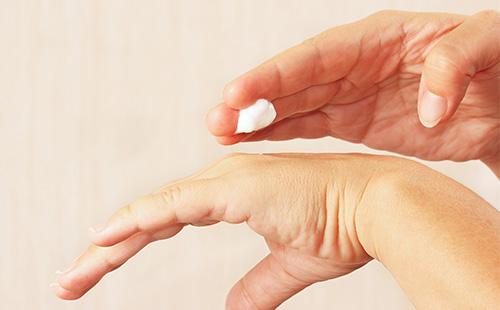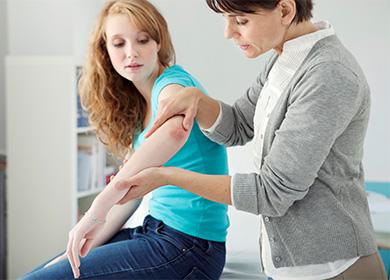The content of the article
Plaque parapsoriasis is a group of skin diseases that have a common manifestation: scaly, rashes raised above the surface of the dermis. They can look like papules or plaques, located on the trunk, proximal limbs. However, these conditions have different pathogenesis, histopathology and, accordingly, require a separate therapeutic approach. In ICD-10, the pathology is placed under the code L41.
The name of the disease was first proposed in 1902 by French dermatologist Louis Brock. Initially, he described three main forms of parapsoriasis:
- small patchy and large patchy;
- lichenoid;
- teardrop-shaped.
Later, the Haberman-Much variant was also assigned to this group. The pathogenesis of this disease is based on the formation of infiltrates consisting of T cells. Why such changes occur on the skin is still unknown.
Main forms
Small-scaled parapsoriasis in adults is a benign disorder that rarely progresses. Coarse plaque may have a more sinister outcome, since in 10% of cases, T-cell lymphoma forms against its background. Some researchers even consider it as the initial stage of a malignant neoplasm. Small-patchy pathology usually lasts from two to three months to several years, and then can be resolved spontaneously. The large-plaque variant often has a chronic course and requires mandatory treatment, since it can result in the formation of lymphoma.
Mechanisms of occurrence with photos
According to scientists, these forms of dermatoses are different stages of lymphoproliferative disorders - from chronic dermatitis to apparently malignant cutaneous T-cell lymphoma.
- Small patchy. The reactive process implemented through T-cells CD4. The picture is similar to changes in chronic dermatitis. However, some experts believe that this may be an abortive form of T-cell lymphoma. It manifests itself as well-defined spots with a scaly surface. Diameter - less than 5 cm. Localized on the trunk and limbs, do not itch. A typical example is elongated finger-shaped rashes located in a specific dermatome and localized on the lateral surface of the chest or abdomen.
- Large patchy. This form is associated with a chronic inflammatory process. Histologically, it is benign, without the presence of atypical lymphocytes. Otherwise, it is considered as the initial stage of lymphoma. Manifested by weak erythematous spots with arched contours. Each rash often has dimensions of more than 6 cm. Such elements are localized on the proximal limbs and trunk, sometimes resembling a “bathing suit”. The surface of the rashes is red (salmon), covered with thin flakey scales on top.
Epidemiology
There are no exact statistics on the incidence of pathology.Perhaps this is due to diagnostic problems: many patients simply underestimate the symptoms, especially when they are dim. Approximate figures: 3.6 cases per 1 million people per year.
If we are talking about a small-patchy form, then there have been no cases of complications or deaths. With tibial plaque, complications are associated with the development of T-cell lymphoma, in this case, the five-year survival rate of patients is 90%.
The small-patchy option is more common in male patients. The ratio between men and women is 3: 1.
Clinical manifestations
In most cases, the pathology is characterized by a slow start. Rashes appear gradually, become clearly noticeable after a long period of time. Some people have extra skin elements.
The small-patchy option can last this way from two to three months to several years. The disease has a favorable prognosis - after episodes of exacerbation, rashes can disappear spontaneously.
Tibial also proceeds chronically, develops over many years, and sometimes decades. May progress to fungal mycosis, cutaneous T-cell lymphoma. Without appropriate treatment, remission in this case does not occur.
Diagnostics
Differential diagnosis is carried out with the following diseases:
- allergic contact dermatitis;
- cutaneous T-cell lymphoma;
- nummular dermatitis;
- guttate psoriasis;
- pink lichen;
- syphilis.

Laboratory research
A blood test is performed to count the number of leukocytes and their differentiation. A high level of lymphocytes or the presence of Cesari cells makes it possible to suspect a mushroom mycosis or cutaneous T-cell lymphoma.
According to indications, a biopsy of the area with rashes can be performed. Then a histological analysis of the sample is performed. This is especially necessary for suspected lymphoma.
Treatment
Usually, with parapsoriasis, conservative treatment is recommended, which in most cases is effective. Applicable:
- local preparations with a softening effect;
- corticosteroid hormones;
- phototherapy;
- combining phototherapy with psoralen.
The treatment regimen is compiled individually by the attending physician, depending on the severity and severity of the process.
Small patchy
Since this type of pathology rarely progresses, the treatment consists in stopping the symptoms. Usually limited to the appointment of local skin care products. Fat-based gels and ointments with a softening effect are recommended. In some cases, ointments with glucocorticoid hormones (class III-V) can be prescribed. According to some experts, they have a more pronounced clinical effect.
With a high prevalence of rashes on the body, phototherapy is indicated. Narrow-band UV irradiation is most effective, in many cases it leads to remission. In the absence of a significant effect, PUVA therapy with treatment with psoralen and long-wave ultraviolet radiation is indicated.
Oversized
In this case, treatment is carried out without fail, since it prevents the progression of the process and reduces the risk of lymphoma. The following local drugs may be included in the scheme:
- middle or high grade corticosteroids (II-IV);
- mustard nitrogen gas (mustargen);
- carmustine.
Therapy is monitored every two to three months. Phototherapy is performed using broadband or narrowband UV radiation. The PUVA method also gives a good effect. In most patients, it contributes to remission.
With the progression of rashes or a change in their morphology, the question of a skin biopsy is considered.
Lifestyle and diet
Refusing bad habits, strengthening the immune system with the help of a balanced diet are factors that help achieve remission. If there are rashes on the skin, you need to stop smoking. Alcohol is permitted only in moderation, occasionally.
For patients with dermatological problems, a special Pegano diet has been developed. At its core are products with an alkalizing effect. At the same time, dishes that contribute to the acidification of the body must be limited. There is a special table in which alkaline reactions of products are reflected. On its basis, you need to make a menu. The diet must include:
- salads - made from fresh fruits and vegetables, seasoned olive oil or natural yogurt;
- porridge — oatmeal, buckwheat, rice, barley;
- soups - on vegetable and cereal broths;
- vegetables - baked in the oven or steamed;
- sea fish - better than fatty grades;
- bird - chicken or turkey;
- bread - with bran or wholemeal.
Lichenoid
This pathology is distinguished by scaly rashes of a papular nature. They have a reddish or reddish brown hue. Most often localized in the trunk or extremities. They look like stripes that intersect with each other.
Usually lichenoid type is benign, after a period of exacerbation, spontaneous resolution occurs. Sometimes rashes persist on the skin for a long time.

Teardrop
This variant of the disease is characterized by the presence of specific rashes: pea-sized nodules, pinkish or brownish in color. At the center of this formation are grayish scales. Diagnose pathology based on specific phenomena:
- wholeness - flakes on the surface of the rashes can be removed entirely;
- peeling - if you scrape the upper part of the nodule, then pityriasis peeling is observed;
- blood - Strong scraping provokes the release of blood droplets.
The course of the drop-shaped type of pathology can be acute, subacute or chronic. Acute is sometimes accompanied by fever or malaise. Some patients have enlarged lymph nodes. Chronic can last for years. Exacerbations are more likely to occur in the autumn-winter period.
It occurs more often in people of a young age (up to 30 years), adolescents. The relationship of this form with the transmitted infectious diseases (tonsillitis, acute respiratory viral infections, measles, chickenpox) is established. After the disappearance of the rashes, usually there are no traces on the skin, areas of leukoderma are rarely observed.
Treatment involves the appointment of the following groups of medicines:
- penicillin antibiotics;
- antihistamines and anti-allergic drugs ("Cetirizine", calcium chloride, calcium gluconate, sodium thiosulfate);
- vitamin complexes with D2;
- Ascorutin a nicotinic acid.
Also, with this form of pathology, antimalarials are effective, for example, Delagil. Glucocorticoids are prescribed according to indications. They can be used both in tablet form and in the form of ointments. A good effect is given by treatment with light rays, in particular PUVA therapy. There are recommendations for the use of phonophoresis with solcoseryl ointment.
Haberman-fly
He was assigned to this group of diseases much later than the classical triad. A feature is the acute onset of pathology and the presence of characteristic polymorphic rashes. Skin elements may be different:
- vesicles;
- pustules;
- papules;
- hemorrhagic elements;
- necrotic nodules.
Patients may complain of general malaise, fever, headache, sometimes reveal an increase in lymph nodes.
The rash is localized not only on the limbs, but also on the scalp, feet, hands. Relatively rarely, skin elements are located on the visible mucous membranes. Rashes are prone to extensive spread, usually located symmetrically. Gradually, the symptoms regress, in some cases small scars remain.
Manifestations of parapsoriasis have a different severity, differ in polymorphism, and intensify during an exacerbation of the disease. Moreover, each form of pathology has its own characteristics, requires a separate therapeutic approach. That is why the diagnosis of this disease should be occupied by a doctor with the appropriate qualifications.

